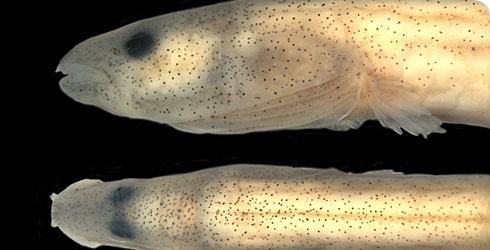Chaudhuria ritvae
Chaudhuria ritvae is a tiny fish species that was first spotted in 2003 during a collecting trip sponsored by the Axelrod Fund, Division of Fishes, Smithsonian Institution. It was first described in 2010 by Dr Ralf Britz, a fish researcher here at the Museum.
Earthworm eels of the family Chaudhuriidae are very elongate percomorph fish that are less than 10 centimetres long with spineless fins.
They live among dense aquatic vegetation and leaf litter, in standing or slowly-flowing waters of small streams, lakes and ponds in India, Indochina and the Sunda islands.
Species detail
The family Chaudhuriidae, with its new addition Chaudhuria ritvae, comprises 10 species in 6 genera
- Chaudhuria caudata
- Chaudhuria fusipinnis
- Chaudhuria ritvae
- Pillaia indica
- Pillaia kachinica
- Garo khajuriai
- Nagaichthys filipes
- Chendol keelini
- Chendol lubricus
- Bihunichthys monopteroides
Species of the genera Chendol, Bihunichthys and Nagaichthys are restricted to peat swamp forest habitats in Sundaland, whereas members of the other 3 genera live in less extreme water habitats in India and Indochina.
Earthworm eels are secretive, mostly nocturnal fish that feed on small invertebrates including insect larvae and small crustaceans. Little is known about their biology, ecology and reproductive behaviour, with the exception of Chendol keelini (see Kerle et al 2000).
-

Taxonomy
At first glance, the 3 known species of the genus Chaudhuria look alike. Find out how you can tell them apart.
-

Distribution
Chaudhuria ritvae was first found in a shallow 20m stretch of water in the Ayeyarwaddy delta region of Myanmar. Find out more.
-

References
Get reference information for Chaudhuria ritvae.
Images

Holotype of Chaudhuria ritvae BMNH 2010.7.21.1.
© Ralf Britz
Chaudhuria caudata from Inle Lake in Myanmar - a close relative of Chaudhuria ritvae.
© Ralf Britz
Living Nagaichthys filipes from peat swamp forests in Sarawak, one of the smallest earth worm eel species.
© Sebastian Lavoué
Living Pillaia indica, the largest earthworm eel.
© Ralf BritzAbout the author

Dr Ralf Britz
Researcher in the Zoology Fish Research Group who has discovered numerous fishes and named a total of 40 new freshwater fish species, including Danionella dracula.
A word from the author
"I hold a great fascination for tiny fishes, and this is another species that may be easily overlooked due to its size, uniform colouration and secretive lifestyle. It was collected by my wife Ritva Roesler and named after her, honouring her support of my work."
Toolbox
Glossary
Branchiostegalrays
Elongate bones that support the gill membrane.
Ethmoid
The ethmoid bone in the skull separates the left and right nasal cavities.
Fenestration
Holes or openings.
Melanophores
Pigment cells containing a black pigment, melanin, that appears brown or black.
Myomeres
Short bundles of muscle fibres.
Myosepta
Thin layers of connective tissue that separate myomeres.
Pterygiophores
Fin supports. A series of bones with which the fins articulate and are further attached by muscle.

